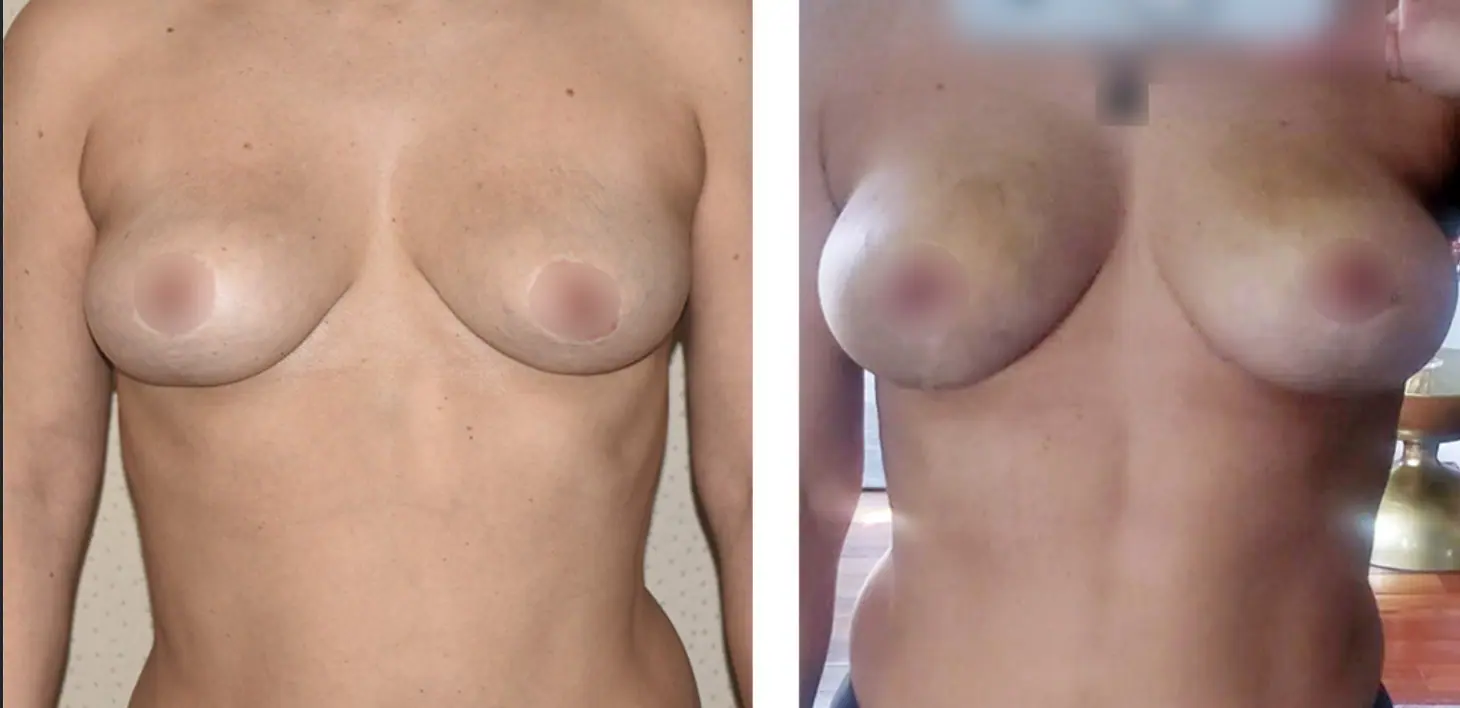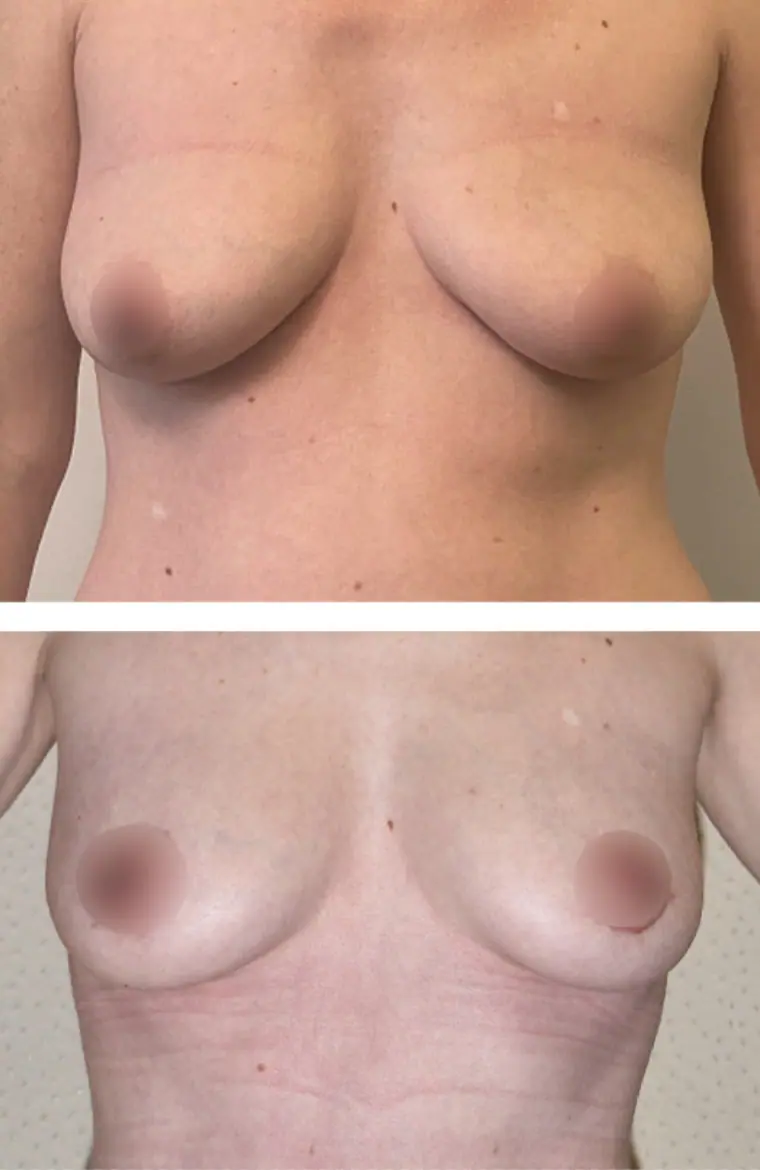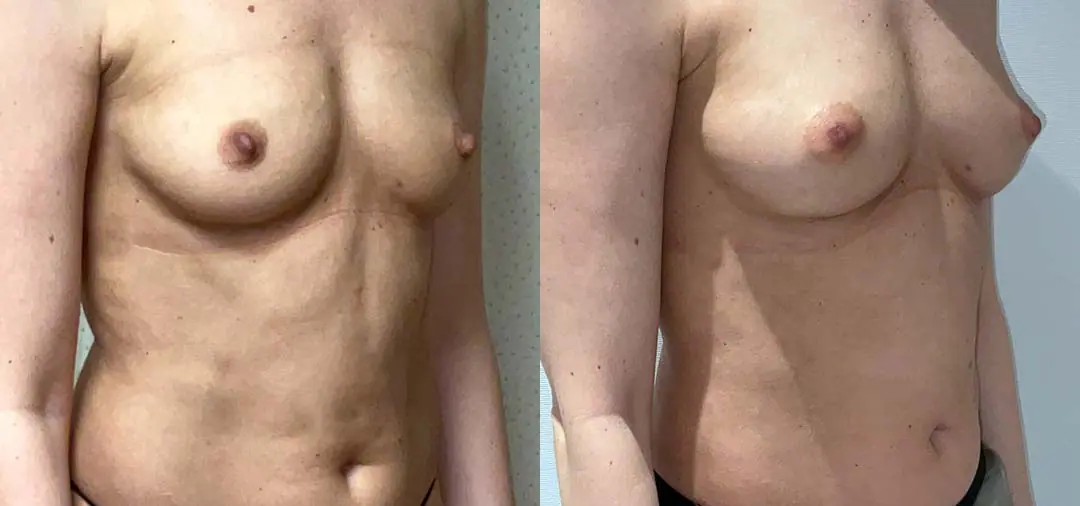Fat transfer breast augmentation has emerged as a popular alternative to traditional breast implants for women seeking subtle breast enhancement.
Instead of silicone or saline implants, fat transfer uses the patient’s own fat cells to increase breast size and achieve a more youthful, symmetrical appearance.
How Does Fat Transfer Breast Augmentation Work?
During fat transfer breast augmentation, excess fat is removed from another part of the patient’s body via liposuction.
Common sites for fat harvesting include the thighs, abdomen, flanks or hips. The harvested fat cells are then processed and purified before being carefully injected into the breasts through small incisions.
Fat transfer generally enables women to gain up to one cup size through an all-natural method. It also provides the benefit of body contouring, as liposuction removes unwanted fat from problem areas. The transplanted fat cells are permanent and behave just like the existing breast tissue.
Reasons for Fat Transfer Breast Augmentation
There are many reasons why a woman may choose fat-based breast enhancement. Some of the more common causes of hypomastia (small breasts) are: genetics, loss of breast volume with age and loss of breast volume with weight loss.
Regardless of the cause, many women who do not desire implants have achieved their desired breast size thanks to significant advancements in cosmetic surgery. While many women opt for breast implants, other NYC women have gone for a natural breast enhancement alternative: fat transfer to the breasts.
What is Fat Transfer?
An autologous fat transfer is a cosmetic surgery to move fat from one part of a patient’s body to another. It aims to remove unwanted fat from a specific area, like the thighs or tummy, and use it to increase the size of other areas, such as the buttocks or breasts.
What is Breast Augmentation?
Breast augmentation is a cosmetic procedure that aims to enlarge, change the shape of, or improve the tone of the breast. The primary techniques used include fat grafting and breast implants, or a combination of the two.
Benefits of Fat Transfer Breast Augmentation
Compared to breast implants, fat transfer offers several key advantages:
- 100% natural: No foreign objects are placed inside the body. The fat cells are your own tissue.
- Minimal scarring: Only small injection sites are required, not true surgical incisions.
- No implant-related risks: No concerns about capsular contracture, implant rupture or other foreign body-related issues.
- Dual-benefit: Liposuction slims areas with excess fat.
- Natural feel: Breasts maintain a soft, natural texture and movement.
- Minimal downtime: Most patients resume normal daily activities within days.
- Precise, bespoke process: Additional touch-up transfers can be performed until the perfect size and shape is achieved.
Ideal Candidates for Breast Fat Transfer
The best candidates for fat transfer breast augmentation are individuals who:
- Want to increase their cup size by about one size. Significant enlargement is not reliable through fat transfer alone.
- Have excess fat in areas like the abdomen, flanks, thighs or hips that can be removed via liposuction.
- Do not smoke. Smoking increases the risk of fat graft loss.
- Have a lower BMI. Women who are overweight have lower fat graft retention rates.
- Do not have very tight breast skin. Tight skin can limit graft volume..
- Have realistic expectations about the volume increase possible through fat transfer.
Your Fat Transfer Consultation with Dr. Smith
During your initial consultation with board-certified NYC plastic surgeon Dr. Darren Smith, he will:
- Evaluate your breast characteristics and aesthetic goals.
- Perform 3D imaging and use this in conversation with you to design your ideal outcome
- Assess potential fat donor sites like the abdomen, flanks, hips or thighs.
- Discuss your medical history, medications, smoking and other factors that affect your candidacy.
- Explain the complete fat transfer procedure from liposuction to fat injection.
- Answer any questions you have about expected results, recovery and risks.
If you decide to proceed with treatment, Dr. Smith will develop a customized surgical plan to help you achieve a natural breast enhancement with your own fat.
How Do I Prepare for a Fat Transfer?
Preparing for a fat transfer procedure involves several essential steps to ensure you achieve your desired look and feel, while also prioritizing your health and well-being. Here’s how to prepare:
- Consultation with a board-certified plastic surgeon is crucial. During this consultation, you’ll undergo 3D imaging to determine the ideal size and shape goals that align with your anatomy.
- Prioritize reaching your stable goal weight before the procedure. This not only enhances the results but also supports your overall health and well-being.
- Ensure that you are in optimal health. This includes addressing any underlying health concerns to minimize risks and promote a smooth recovery.
- Pay close attention to your skin’s condition. Healthy skin plays a vital role in the success of the procedure and the overall look and feel of the outcome.
- Follow your doctor’s instructions diligently. This includes avoiding any medications, supplements, or substances as recommended both before and after the fat transfer procedure. Proper compliance is essential for your health and the quality of your results.
- For optimal health, it’s crucial to stop smoking at least 4 weeks before and after the procedure. Smoking can adversely affect the health of your blood vessels, dramatically limiting the success of the procedure.
The Fat Transfer Breast Augmentation Procedure
On the day of your treatment, Dr. Smith will:
- Perform liposuction on the predetermined donor site(s) to harvest fat cells. This is done under general anesthesia or IV sedation. The most viable portions of the suctioned material are separated and purified.
- Strategically inject the prepared fat cells into different planes and locations within the breast through small incisions. Precise placement helps maximize fat graft survival.
- Complete the process gradually until the desired volume and shape are achieved.
- Close the injection sites with sutures and apply compression dressings to the liposuction areas.
You can go home the same day to begin your recovery.
Recovering from Fat Transfer Breast Augmentation
Patients should set aside 1-2 weeks for full recovery following fat transfer to the breasts, however most can return to a desk job within 48 hours. Typical postoperative guidelines include:
- Avoiding strenuous activity or exercise for 3-4 weeks. Light walking can commence after a few days.
- Wearing a compression garment on liposuction sites for about 4 weeks to control swelling.
- Avoiding underwire bras to prevent graft displacement. Sports bras or soft bras without cups can be worn for support.
- Sleeping on your back and avoiding pressure on the breasts.
- Taking prescribed medications to manage discomfort. Pain, swelling and bruising will subside over 2 weeks.
- Keeping incisions clean while they heal. Most dressings can be removed after 48 hours.
- Returning for follow-up visits so Dr. Smith can monitor your progress.
Fat Transfer Breast Augmentation Before And After
Fat transfer breast augmentation is intended to achieve a maximum of about 1 cup in size increase due to pressure on the fat graft from the breast skin at greater volumes.
Patients seeking larger changes can consider an additional round of transfer 6 months after the initial procedure. The patients shown here were looking for a natural appearance and modest size increase, and therefore opted only for a single round of fat transfer. File names are captions.
Results of Fat Transfer Breast Augmentation
Final results emerge gradually over 3-6 months as inflammation resolves and the transferred fat adapts to its new blood supply. On average, about 70% of the injected fat survives.
Touch-up fat transfer procedures may be recommended after several months to fine-tune your results if you wish to gain additional volume. Otherwise, the grafted fat cells are permanent and will last your lifetime.
With customized planning by an experienced surgeon like Dr. Smith, you can enjoy beautiful, natural-looking breast enhancement through your own fat transfer.
FAQs About Fat Transfer Breast Augmentation
How much fuller will my breasts look after fat transfer?
Fat transfer generally allows for a modest one-cup size increase at most. Significant enlargement requires implants. We can help simulate expected results with advanced 3D imaging to see if this is a good choice for your desired goals.
Do I need to have my initial fat transfer procedure repeated?
Approximately 70% of fat is retained after these procedures. If additional volume is desired, a secondary round of fat grafting can be performed.
Cost of Fat Transfer Breast Augmentation
Fat transfer breast augmentation is an advanced, highly-specialized technique. Pricing will vary depending on the size and complexity of each case. Expect costs to range from $12,000 to $20,000.
However, these costs can vary by geography, surgeon’s qualifications, and other factors. Please get in touch so we can provide you with a better estimate for your specific situation. Diet and lifestyle choices can also impact the overall cost.
Does fat transfer interfere with breast cancer screening?
Fat transfer-based breast augmentation does not increase the risk of breast cancer. Fat grafts can, however, create false positives on mammograms resulting in the need for additional testing..
Am I a good candidate for fat grafting?
The best candidates for fat grafting have localized fat deposits that can be used for fat transfer. They typically desire subtle enhancement. Patients should discuss their medical history, including pregnancy, nursing, and any history of breast disease, with their surgeon to determine candidacy.
Does fat transfer to the breast last forever?
On average, about 70% of the fat transferred to your breasts will last permanently. However, fluctuations in weight, diet, and other factors can affect results.
Fat cells in the breasts, as in other areas, can expand and shrink in response to lifestyle changes. Maintaining a stable weight and a healthy diet can help preserve your results.
How many times can you do a fat transfer to the breast?
The number of times fat transfer can be performed depends on factors like available adipose tissue and the skin’s ability to accommodate added volume. Mastopexy (breast lift) may be considered in conjunction with fat grafting to achieve desired results.
Board certification by the American Board of Plastic Surgery ensures that your surgeon has the expertise to guide you through these decisions.
Schedule Your Fat Transfer Breast Augmentation in NYC
To learn more about enhancing your breasts naturally with your own fat, contact Dr. Smith’s New York City practice today to arrange your private consultation.





